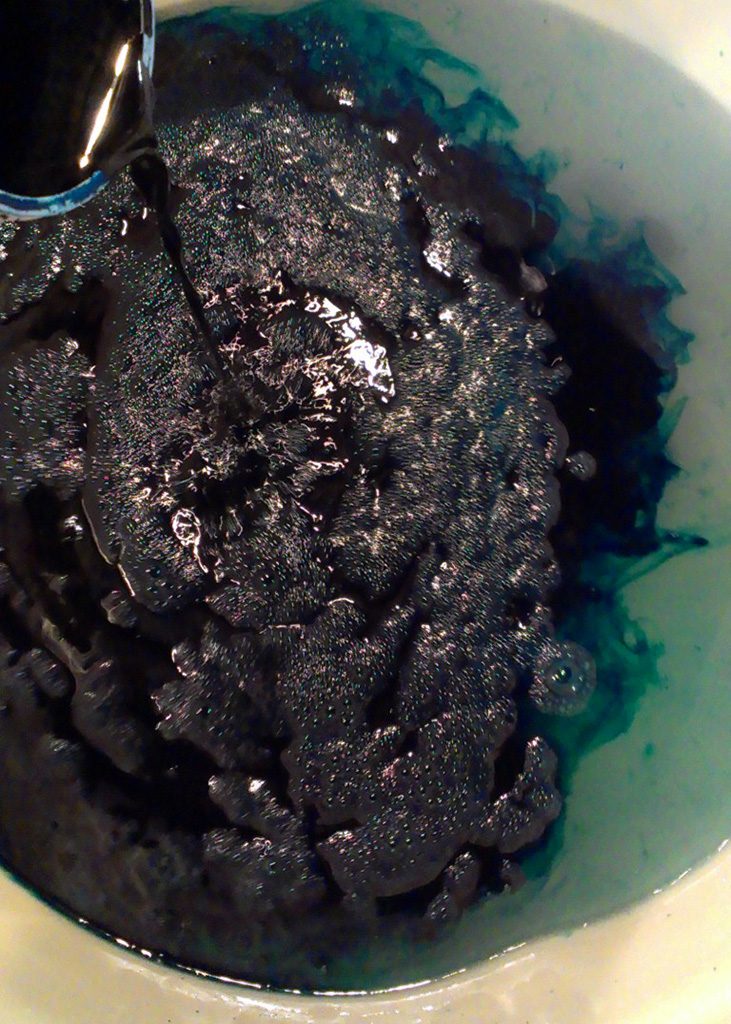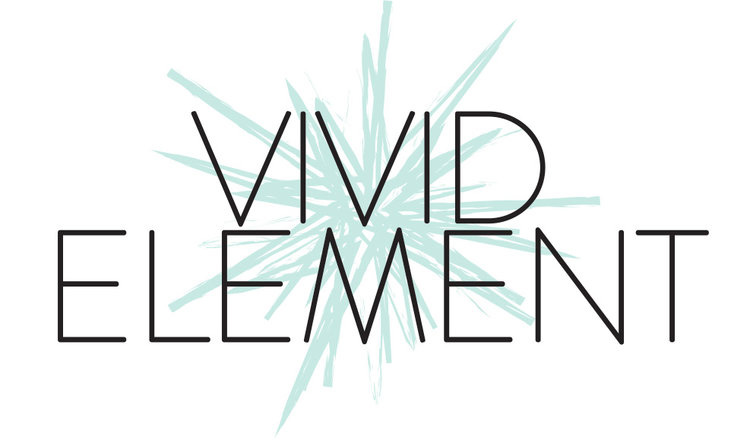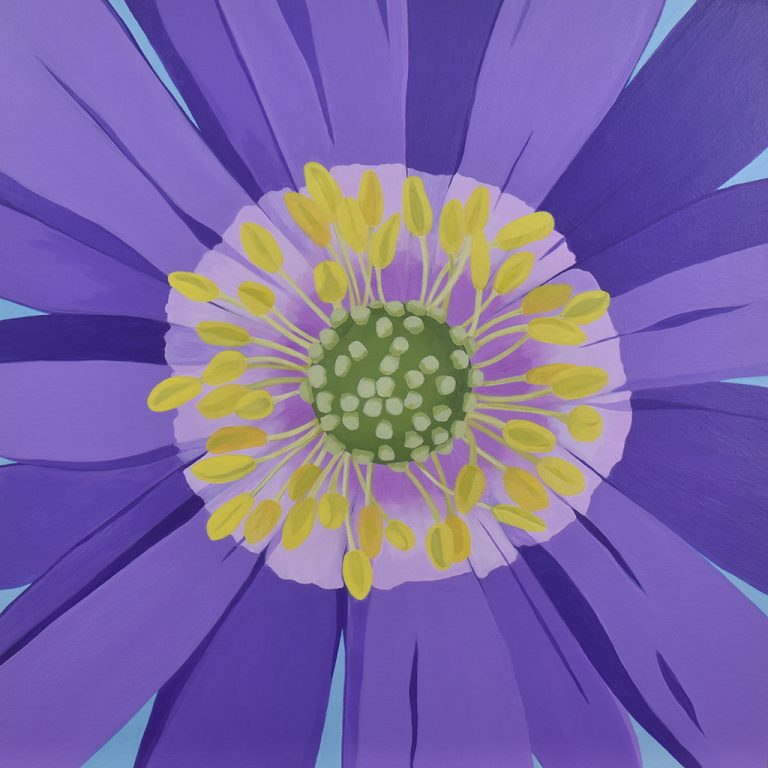Using my own hand dyed organic fabric to make clothing of my own design is thrilling. Color is my main creative passion! I love attempting to recreate a color that is in my mind such as a brilliant blue green or a neon orange by mixing my own color recipes and using that to create the hue on fabric. I’ve been dying fabric since I was a teenager. I started with lots of tie dye, have used natural dyes, taken classes, and now I focus on solid color immersion dying. I use Procion Fiber Reactive Dyes because of the rich vibrant hues that can be created and because the colors are permanent. The dye bonds directly with the molecules in the fiber, so nothing washes out once dyed properly. These dyes are referred to as Low Impact. I recently did some research into what that really means. Being as eco-friendly as possible is also one of my passions, and this is one area in which I know I am not perfect. In full transparency I’m sharing what I discovered.
Fiber reactive dyes, when used in the small amounts that a home dyer or a small business would, actually do have a pretty low impact on the environment. The waste water is easily broken down into harmless molecules by microbes in our soil and waste water treatment plants. The chemical used to make the dyes react is soda ash; this is found in laundry detergents and swimming pools and is used in such small amounts that it makes a minimal impact. Salt is also used, but when combined with the rinse water and diluted in the water system, it isn’t a problem. The only heavy metal found in Procion dyes is copper in the color Turquoise and any blends that use Turquoise. I only use basic colors, but Turquoise is one of them, so from here on out I will be adjusting color recipes to eliminate using Turquoise. Other than that they contain no toxic substances. Procion dyes work at low temperatures and have a 70% absorption rate, so little washes out.

However, there are two issues to consider when using Procion dyes. The powder form of the dye is harmful to breathe, but with the use of a face mask and gloves, proper storage, clean up, and ventilation, there are no problems. The other is that the immersion dye process does use quite a bit of water. I discovered a few techniques to reduce the water needed for rinsing and will be implementing them with my next dye batch. These include letting the fabric soak for several hours in hot water after an initial rinse, and should greatly reduce the amount of water needed for final rinsing.
I contacted Dharma Trading, a trusted company I have purchased dye from for over 20 years, for more information. As far as the production of the dyes, this is another area where environmental damage could be a problem, but they assured me that their suppliers are slowly improving their processes, and that in Europe the dyes meet all European Union criteria for being an eco-friendly colorant. It’s hard to find much more info in that area. Dharma also pointed out that the dye actually becomes part of the molecular structure of the fabric.
“…so babies can chew on clothing dyed with these dyes, chemically sensitive folks can wear fabrics dyed with them, and it doesn’t matter how much you sweat either. Fiber Reactive dyes are the ONLY dyes that this is true of. Natural dyes from plants and insects are not permanent. The chemical mordants used with natural dyes are metallic salts and some are highly toxic.“
Dharma Trading co.

With natural dyes it is not possible to create deep, dark color, and the hues created do fade and degrade over time. Very large quantities of plants and lichens, typically equal to or double the weight of fiber itself, need to be used. More time and energy is used to make color with natural dyes than with fiber reactive dyes (you need to heat the water for hours at a time.) Some of the mordants used to make natural dye react, such as tin and chromium, are toxic themselves, although the mordant Alum is safest and most common.

No matter the differences, my gut tells me that dying a gentle color with some plants has got to be better for the planet, but looking at the big picture, Procion Fiber Reactive Dyes are not a problem environmentally. You can’t get the vibrant rich shades that make my heart sing with natural dyes, so for now I will continue to use Procion Dyes with a freer conscience. I’d love to hear your thoughts on this topic!






This Post Has 30 Comments
How will it react with urine, baby diapers
Hi Marianne, it should be fine as the dye is chemically attached to the fibers in the cloth. However, I don’t have direct experience with that. You could ask Dharma Trading. They would know for sure.
Thank you for this article. I’ve always wondered how destructive I am being while dying, and this makes me feel a bit better about it. We use Dharma and Colorado Dyes.
I’m glad you found it helpful. I’ll have to check out Colorado Dyes, that’s a new one for me.
Having spent the day with natural dyes and pots and pots of boiling water for 2 hours each batch, I am so pleased to find this article. This and a book by Helen Deighan I’m about to start with procian dyes.
Thank you
Ann in Scotland
Hi Ann, I’m happy to hear that you found my post helpful. Good look with the dyes!
I startd doing dye work 50 years ago. At one point, I explored natural dyes but was put off by the toxicity of some of the mordants, and the long boiling periods as you mentioned. Plus I thought that if the dyers of old saw the miraculous colour range and extreme fastness of our commercial dyes, they would embrace them with gratitude! I love indigo, but aside from that I am happy with procion dyes.
Thanks for your input. It’s nice to know that I am not alone in my love for the vibrant colors of Procion dyes. I also agree, indigo creates some gorgeous color.
Thank you, this is very helpful. I have just started to experiment with natural dyes and really want to learn more.
Also, that dress is amazing!!!
Thanks so much! I’m glad you found the blog post helpful. Happy Dying!
Thanks for the share. I also love the vibrancy of the Procion Fiber dyes; I’m learning the ins and outs of acid dyes for synthetics at the moment, so any tips you have on that would be greatly appreciated. I’m currently working to develop a “dry-dye” method that would even further reduce or eliminate the rinsing and washing process… while I appreciate the holistically organic life I strive for, I cannot bring myself to use natural dyes that come from edible plants. Maybe once world hunger has been cured and there’s an abundance of all things edible and vibrant, lol. But I marvel over the richness of beet juice every time I have some, and can never get turmeric stains out of anything, lol. ????
Thanks for your comment. Your new dry dye method sounds intriguing! Yes, it’s more complicated than you would expect when considering natural vs synthetic dyes. I’m thinking of sharing my low water dye/rinse method in a blog post soon. I would love to share more dying or sewing tips if there is any interest in a particular topic. Unfortunately I don’t have much experience with acid dyes.
What a great website I have a question using procion can I mix the dye and transfer into a bottle and cover the product that way? Instead if soaking it in a container ?
many thanks
Hi Rachel, yes you can. You need to soak the fabric in a soda ash & water solution first. This type of application works for tie dye. You would need to mix the dye with Urea. It’s a fun thing to experiment with. The result will not be a solid, uniform color.
After dyeing do you rinse first and then soak or soak first?
One of the clearest and best texts I’ve read on fibre reactive and natural dyes and the environmental impact. (I’m interested in the naturals because I also like to make pen ink) . I’ve always felt a bit guilty about the amount of energy used to extract tannins from bark and galls and your text has given me some great ideas to experiment with. Thanks for your coverage and clarity.
Thanks for the compliments. It’s a tricky comparison with a lot to consider–definitely not as clear cut as it first appears. Natural pen ink sounds cool. Have fun with that!
its a big help for my research project, i am a MS Scholar working on Batik and was searching for best dyes for batik as these can be used with cold water so perfect for my project.
Thank You.
I’m glad you found this blog post helpful!
are all procion dyes the same. im trying to find the best value for money in Australia cos getting the over seas is expensive.
Hi Sarah, I would assume that they are similar, but you’d have to compare the brands. I’ve worked mostly with Dharma’s dyes.
Hi! I appreciate all of this information as I only became aware of the fugitive nature of natural pigments throughout the dyeing process. I’ve decided that once I forgo the need for permanence , the fading is less of an issue. After all, the sun will fade even commercial dyes. And in terms of heat, I use the sun mostly these days. Making the baths sometimes requires heat (like with curly dick) but usually I add the pre washed and mordanted fiber to a jar with my dye stuff and let the sun do it’s business. I realize that folks will want more options and I’m worried about water so I’m going to try these dyes. I bought my first one in avocado. So you don’t need to prepare the organic cotton?
Thanks for your thoughts about natural dyes. Using the sun sounds like a great idea. I like to make tea that way, too! With Procion dyes it’s best to soak your fabric in water first for at least an hour, so that it’s entirely saturated (if you are going for a solid, even color.) That’s the only prep I do. Good luck!
What a great article. I’ve just started using procion dyes – well, I’ve just started experimenting with dyeing of any kind! I was a bit concerned about all the water and washing I had to do – and to be honest, my initial attempts were disappointing. I’ll try your idea of a long soak to cut down on the post dyeing washing. It’s great that people are starting to consider the environmental impact of everything we do. Sometimes it feels overwhelming – but asking the right questions and making informed decisions seems to me the best way to go!
Best wishes, Tim (London)
It does take some practice to get the results you want with dying. Enjoy the process, and be sure to keep notes for future batches. I agree, sometimes it does feel overwhelming to try to be completely eco-friendly. I think taking small consistent steps is helpful, and slowing down enough to research and ask questions before purchasing anything is key. Best of luck!
After dyeing do you rinse first and then soak or soak first?
Hi Mike, for a lower water rinse method I’ve found this to work well: 1 Hot rinse, then soak in Cold water overnight. Next, 1 Hot wash (with Dawn or synthapol, etc) and finally 1 rinse, making sure water runs clear. Good luck!
I adore your homemade dye chart. ?? And great info, thank you!
Jeanne, thanks so much. It took a while to make but was worth the effort. I’m glad you found the info helpful!